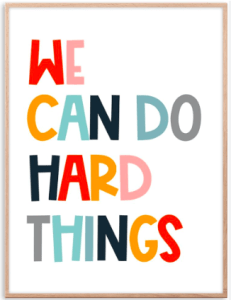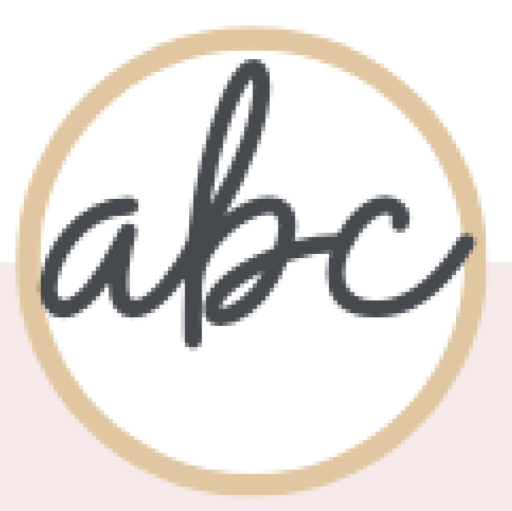The first part of changing a system is having the right mindset and belief system, but then there is a lot of work to do to build a skill set and a system that embraces variability and equity.
When my team was starting to re-enter the building post-lockdown, I had purchased each individual person a white photo frame, and printed colorful posters that said, “We can do hard things.”. I hand-delivered
 them to every classroom teacher, special educator, essential arts teacher, school counselor, interventionist, office member, etc. I was immensely proud of the work we had accomplished together through one of the most traumatic shared experiences we’ll ever encounter. We also proved to ourselves, and our community, that we can rise to the challenge and we’re not afraid of doing what it takes to support all of our students.
them to every classroom teacher, special educator, essential arts teacher, school counselor, interventionist, office member, etc. I was immensely proud of the work we had accomplished together through one of the most traumatic shared experiences we’ll ever encounter. We also proved to ourselves, and our community, that we can rise to the challenge and we’re not afraid of doing what it takes to support all of our students.
I was not prepared for the varied responses and feedback I received when I delivered these framed posters to individuals. Some were appreciative, some were moved, some were proud, and some were irritated and frustrated. When I asked for more detail about why the poster made them feel frustrated, they said “I don’t want to do hard things anymore, I’m exhausted. I don’t know how much more I have in me to keep up with the additional responsibilities and demands that have been put on educators. When I look at that poster, it makes me realize that our work is never done, and there will constantly be new challenges that we are expected to overcome.” Whew.
The mental, emotional, physical, and social shift that the pandemic has exposed is real, and three years later we’re still learning how to adjust. What that teacher expressed was her honest, raw, and real state of where she was at in that moment. And I so appreciated hearing it from her, because I know that others are feeling that way too, but she was brave enough to name it out loud for me. I needed to hear that because that is not how I think, feel, or act as an educational leader.
My teaching team has heard me passionately talk about Universal Design for Learning and Multi-Tiered Systems of Support for about 7 years now, and initially, I thought the way to get people to listen and put these elements into practice was to explain how beneficial it is for ALL students – because that is our common denominator afterall, right? The students. We do this hard work for the students – we keep showing up for the students. The teachers need to see how the system supports them, in addition to the supporting the students. We need the adults to recognize how UDL and MTSS, benefit the adults, who are caring for our students. We have developed an interdependent system that relies on layered supports and services to help all students show growth toward or beyond proficiency.
As educators, we’re all lifelong learners, so I simply took off the word ‘students’ and was explicit and intentional about highlighting the benefits of UDL and MTSS for ALL (including adults). This has been a game-changer for quite a few of my faculty and staff members. We are fortunate to have an embedded Special Educator Model in my building – which means we have one special educator on every grade-level team. We started incorporating what used to be individual accommodations to universal best practices ie flexible seating options, we started shifting to more of a push-in intervention model (with some pull-out services), we began doing more guided group work and fewer whole class lessons, etc. Teaching teams are recognizing that it might take a bit more effort and energy initially, but they see that the results are worth it, when they see the increase in student engagement, participation, and application of learning. This reframing has shifted our mindset and belief system, which enabled us to establish a highly effective multi-tiered/layered support system within our school. (More on this in a future post.)
UDL is a framework for designing learning experiences, so students have options for how they learn, what materials they use, and how they demonstrate their learning. When implemented with a lens of equity in a multi-tiered system, the framework has the potential to eliminate opportunity gaps that exclude many learners, especially those who have been historically marginalized. If we want all students to have equal opportunities to learn, we have to be incredibly purposeful, proactive, and flexible (Novak, 2021).
Another (more current) experience that has helped people open up to the idea of Universal Design for Learning has been our recent influx of newcomers and multilingual students joining our school community. We welcomed 29 newcomers (mostly from Africa) within about 2 months, into a community that had 96% of the population identifying as English-speaking Caucasians. This caught some of our educators off-guard and they felt underprepared to support these students in their general education setting. We have an incredible three-person Multilingual Department (ML) that supports students within the classroom and has offered UDL suggestions to teachers such as ‘add more visuals’, ‘label materials’, ‘move posters to student eye height’, etc. We brought in outside guest speakers to offer ML trainings (which also brought up ways to incorporate UDL), but teachers only attended if they currently had a student who was working with the ML dept. It wasn’t until we provided an opportunity for a few of our teachers to visit another school in our state (not in our district) that has a well-established ML Program for newcomers, and they got to see UDL in action. That’s when the light bulbs started turning on…those teachers are now seeing how putting UDL elements in place in any classroom will benefit all students (and themselves) because they would already be prepared to welcome any student into their classroom, any time. I am confident that this experience is what will be the catalyst for our school system to start embracing variability and equity using the Universal Design for Learning Framework. Below, is a two-page coaching guide I created for an administrator or coach to share (or use to develop professional learning experiences) with an educator as they start to design inclusive learning experiences for all.
Now, if only I could get my district’s facilities and finance department to see the power of investing in some significant facility upgrades – we could really be more welcoming, accessible, and inclusive. We’ll get there, eventually. (I’m pretty persistent!)
